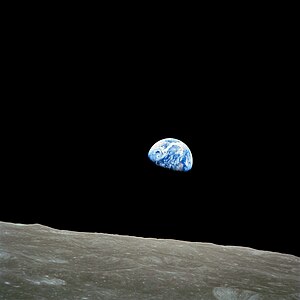And I think it is the plan of Rich people like Trump that this happens. It's also the reason why he thinks nuking North Korea is a very good idea. It's about reducing the population of earth wherever he can.
Begin quote from:
Spaceship Earth
Spaceship Earth
The earliest known use[1] is a passage in Henry George's best known work, Progress and Poverty[2] (1879). From book IV, chapter 2:
It is a well-provisioned ship, this on which we sail through space. If the bread and beef above decks seem to grow scarce, we but open a hatch and there is a new supply, of which before we never dreamed. And very great command over the services of others comes to those who as the hatches are opened are permitted to say, "This is mine!"George Orwell later paraphrases Henry George in The Road to Wigan Pier:
The world is a raft sailing through space with, potentially, plenty of provisions for everybody; the idea that we must all cooperate and see to it that everyone does his fair share of the work and gets his fair share of the provisions seems so blatantly obvious that one would say that no one could possibly fail to accept it unless he had some corrupt motive for clinging to the present system.In 1965 Adlai Stevenson made a famous speech to the UN in which he said:
We travel together, passengers on a little space ship, dependent on its vulnerable reserves of air and soil; all committed for our safety to its security and peace; preserved from annihilation only by the care, the work, and, I will say, the love we give our fragile craft. We cannot maintain it half fortunate, half miserable, half confident, half despairing, half slave—to the ancient enemies of man—half free in a liberation of resources undreamed of until this day. No craft, no crew can travel safely with such vast contradictions. On their resolution depends the survival of us all.[3]The following year, Spaceship Earth became the title of a book by a friend of Stevenson's, the internationally influential economist Barbara Ward.
Also in 1966, Kenneth E. Boulding, who was influenced by reading Henry George,[4] used the phrase in the title of an essay, The Economics of the Coming Spaceship Earth.[5] Boulding described the past open economy of apparently illimitable resources, which he said he was tempted to call the "cowboy economy", and continued: "The closed economy of the future might similarly be called the 'spaceman' economy, in which the earth has become a single spaceship, without unlimited reservoirs of anything, either for extraction or for pollution, and in which, therefore, man must find his place in a cyclical ecological system". (David Korten would take up the "cowboys in a spaceship" theme in his 1995 book When Corporations Rule the World.)
The phrase was also popularized by Buckminster Fuller, who published a book in 1968 under the title of Operating Manual for Spaceship Earth.[6] This quotation, referring to fossil fuels, reflects his approach:
…we can make all of humanity successful through science's world-engulfing industrial evolution provided that we are not so foolish as to continue to exhaust in a split second of astronomical history the orderly energy savings of billions of years' energy conservation aboard our Spaceship Earth. These energy savings have been put into our Spaceship's life-regeneration-guaranteeing bank account for use only in self-starter functions.United Nations Secretary-General U Thant spoke of Spaceship Earth on Earth Day March 21, 1971 at the ceremony of the ringing of the Japanese Peace Bell: "May there only be peaceful and cheerful Earth Days to come for our beautiful Spaceship Earth as it continues to spin and circle in frigid space with its warm and fragile cargo of animate life."[7]
Epcot's Spaceship Earth
Like a grand and miraculous spaceship, our planet has sailed through the universe of time, and for a brief moment, we have been among its many passengers….We now have the ability and the responsibility to build new bridges of acceptance and co-operation between us, to create a better world for ourselves and our children as we continue our amazing journey aboard Spaceship Earth.[9]David Deutsch has pointed out that the picture of Earth as a friendly "spaceship" habitat is difficult to defend even in metaphorical sense. The Earth environment is harsh and survival is constant struggle for life, including whole species extinction. Humans wouldn't be able to live in most of the areas where they are living now without knowledge necessary to build life-support systems such as houses, heating, water supply, etc.[10]
The term "Spaceship Earth" is frequently used on the labels of Emanuel Bronner's products to refer to the Earth.
Literature
- Nicola Armaroli, Vincenzo Balzani: Energy for a Sustainable World – From the Oil Age to a Sun-Powered Future, Wiley-VCH 2011, ISBN 978-3-527-32540-5.
- Nicola Armaroli, Vincenzo Balzani and Nick Serpone: Powering Planet Earth – Energy Solutions for the Future, Wiley-VCH 2013, ISBN 978-3-527-33409-4.
- Italian original edition: Energia per l’Astronave Terra- Quanta ne usiamo, come la produciamo, che cosa ci riserva il futuro, Zanichelli 2008, ISBN 978-88-08-06391-5.
- Sabine Höhler: Spaceship Earth in the Environmental Age, 1960-1990 (History and Philosophy of Technoscience, 4). London: Pickering & Chatto 2015, ISBN 978-1-84893-509-9.
See also
- Overview effect
- Global citizenship
- Gaia hypothesis
- Humankind
- Spaceship Earth (Epcot)
- Nicholas Georgescu-Roegen
- Global catastrophic risk
- Planetary boundaries
- World community
- Sharing economy
- Sustainability
- Environmental protection
- The Zeitgeist Movement
- World peace
- Collective intelligence
- Mass collaboration
References
- <David Deutsch (2011). The Beginning of Infinity. ISBN 978-0-14-196969-5.
|website= (help); |website= (help); 

No comments:
Post a Comment